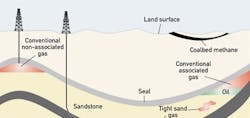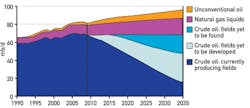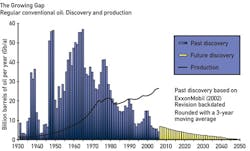Controls for Scraping of the Bottom of the Barrel - Part 1
In my previous series of articles, I described some of the contributions which automation and process control can make to increase the operational safety of the ageing nuclear power industry. In this series, I will discuss the emerging new industries that are aiming at exploiting the "unconventional" fossil fuel deposits. These include drilling for oil and gas deposits under the oceans, in Alaska or above the Arctic Circle. The recovery technologies being used in shale fracturing and oil sand retorting are new and unproved. These "unconventional" recovery technologies are more expensive than the traditional ones, and present even more safety risks than the "conventional" technologies.
Table 1. Global deposits of conventional fossil and nuclear fuels and their consumption rates.
Yet many energy companies have decided to make immense investments to exploit these fuel deposits, instead of investing in renewable energy. It seems that this will remain to be the case for years (possibly decades), and therefore discussing the contributions that automation and process control can make to improve the safety of these emerging industries is justified.Before starting this discussion, let us review the sizes of the global deposits and the rates at which "conventional" fossil and nuclear (uranium) deposits are being consumed (Table 1). While the fossil and nuclear industries are using different energy units, the data in Table 1 is given in zeta joules (ZJ) in order to make them easier to compare.
How Many Conventional Oil Deposits Are Left?
Figure 2 shows the International Energy Agency (IEA) projections of the rate at which the currently producing oil fields around the world will be depleted by 2035, and how the use of other unconventional sources of oil are likely to increase. This figure also shows the projected rate of increase of unconventional oil sources, as well as the rate at which the total production of oil from all sources is expected to rise.
We can note that the projection of total consumption for 2011 was only 83 million barrels per day (mb/d). This projection has already been exceeded. Similarly, the projection of 92 mb/d for 2035 is also below the presently expected demand.
Figure 3 shows the relationship between conventional oil consumption and the rate of discovering new deposits. The units used in Figure 2 were mb/d, while the data in Figure 3 is given in Bb/a (billion barrels/year) units.
Figure 3: Until 1980, discovery of new sources of "conventional" oil sources exceeded production. Since then the yearly amount discoved has fallen below production, and by 2050 discovery of new deposits will fall to zero.
To convert from Bb/a to mb/d, one has to multiply the Bb/a values by 2.74. (The use of dozens of different units is a very unfortunate characteristic of the energy industry). The Exxon data in Figure 3 shows that the rate of discovery exceeded the rate of production until 1980 or so, and since that time, production is rising faster than discovery. According to Figure 3, the rate of discovery today is about one quarter of the global production and will drop to zero by 2050.
The global total of unconventional oil deposits (under the ocean, in Alaska, above the Arctic circle, and in shale or oil sand, etc.) are estimated to be between 2 and 4 trillion barrels (tb), of which one quarter to one half is recoverable. If we assume that the recoverable quantity is 2 tb, at today's consumption rate of 92 mb/d (33.5 Bb/yr), the R/P (reserve/production) ratio for the unconventional oil reserves is about 59.
Conventional and Unconventional Natural Gas Deposits
Natural gas (NG) can be obtained from both conventional and unconventional deposits (Figure 4). The total global deposits of conventional NG amount to about 7000 tcf (trillion cubic feet), while the global consumption in 2010 was about 120 tcf, and is projected to double by 2035.
Figure 4: EIA illustration of the locations of the conventional and unconventional (tight sand, shale, coalbed.) natural gas deposits.
Therefore, at today's rate of consumption, the global R/P ratio is about 58, while it's less at the projected future consumption rates.
According to the EIA, the size of the total conventional (non-shale) NG deposit in the United States in 2009 was 285 tcf, while the American consumption rate in 2010 was 24 tcf, giving an R/P ratio of 12 at today's rate of consumption. This rate is projected to triple by 2035.
[pullquote]If we consider the unconventional (shale) deposits, the EIA estimates the "technically recoverable" amount in the United States as 827-1112 tcf. Some industrial sources estimate it to be 2000 tcf or more. Therefore, using today's rate of consumption and the IEA estimate range, the R/P ratio for "unconventional" natural gas from fractionable shale deposits is from 35 to 46.
Today the amount of shale gas and shale oil that is recoverable by "fracturing" is unresolved and is debated. For example, until 2011, the "Marcellus Reserves" (ranging from Virginia to New York state) were estimated as over 400 tcf, while this year the U.S. Geological Survey reduced that estimate from over 400 to 84 tcf. Right now, it seems that "fracking" will continue, and shale production will increase from the present 14% of the total U.S. gas production in 2009 to 45% by 2035. Profit considerations will win over scientific and environmental ones.
I provided the above data, because we live in an age when the freedom of speech is interpreted by some as the freedom to lie. While it is profitable for some to claim that fossile fuels are plentiful, and that the present "energy status quo" is sustainable, I think the readers of this column should know the scientifically established facts. In the coming parts of this series, I will focus on the role that automation could play in improving the safety of the unconventional fossil fuel recovery processes.






